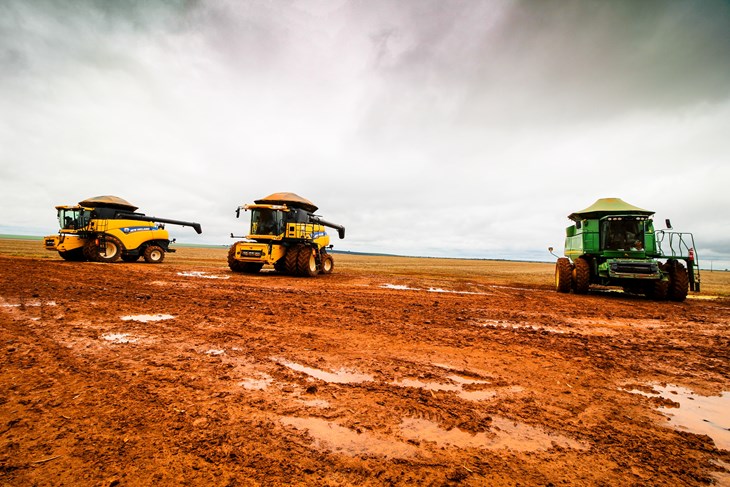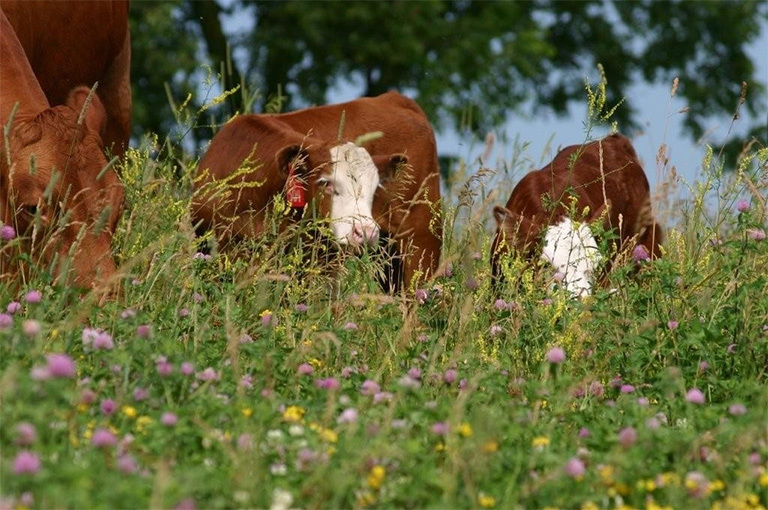Introduction to the problem and scale
- Research has established nine planetary boundaries, which if crossed, could generate irreversible environmental changes and drive the planet into a much less hospitable state. In the case of biodiversity loss, we have not only crossed the boundary but have entered a high-risk zone.2
- Global populations of mammals, birds, amphibians, reptiles, and fish have decreased on average by 68% between 1970 and 2016.3
- Despite broad environmental policy efforts, species extinction rates are increasing.4 42% of terrestrial invertebrates, 34% of freshwater invertebrates, and 25% of marine invertebrates are considered at risk of extinction. Around 1 million plant and animal species are now threatened with extinction.5
- Continued rates of biodiversity loss may lead to the extinction of 40% of the world's insect species over the next few decades.6
- Insects provide pollination, natural pest control, and nutrient recycling and are critical to the functioning and stability of ecosystems.7
- More than 75% of global food crops rely on insect/animal pollination.8
- Between $235 billion and $577 billion in an annual global crop, the output is at risk as a result of pollinator loss.9
- 75% of humanity's food is currently generated from only 12 plants and 5 animal species.10
How does factory farming affect biodiversity?

- The United Nations Convention to Combat Desertification (UNCCD) states that livestock production is “perhaps the single largest driver of biodiversity loss.”11
- Industrial agriculture’s huge demand for animal feed has fuelled the intensification of crop production, leading to biodiversity loss.12
- Intensive crop production uses large amounts of pesticides, decimating the insects on which farmland birds depend for food. The use of insecticides and herbicides has also played a major role in the decline in pollinators, such as bees.13, 14
- Factory farming and its monocultures, lead to the loss of abundance and diversity of the wildflowers on which pollinators feed.
- Plant and animal species are also negatively impacted by the loss of hedgerows due in part to changes in farming practices.15
- Thousands of plant and animal species are threatened within the Amazon and Cerrado as the agricultural industry expands for beef and soy production.
- Approximately 420 million hectares of forest have been lost due to changes in land use since 1990. With the rate of deforestation estimated at around 10 million hectares per year.16
- Over 90% of the world’s fish stocks are either overfished (33.1%) or fished to maximum sustainable levels (59.9%).17
- Almost 70% of landed forage fish are processed into fish meal and fish oil (FMFO) representing 20% of the world’s total catch of wild fish18 which in turn is used to feed cattle, pigs, and farmed fish such as salmon, trout, and bass.
- Hypoxic zones (“dead zones”) in oceans refer to a state of reduced oxygen in the water. These can occur naturally, but scientists are concerned with their increased size caused by human activity. The primary cause is nutrient pollution which is threatening marine life.19
- Since the 1960’s, low oxygen areas in the open ocean have increased by 4.5 million km2 with over 500 additional sites located in other water bodies.20
- Reducing meat and dairy consumption would enable cropland to be farmed less intensively and halt the expansion of farmland into wildlife habitats, allowing biodiversity to be restored.
Link to the relevant Sustainable Development Goal (SDG)
- SDG 15: Life on Land: Protect, restore and promote sustainable use of terrestrial ecosystems, sustainably manage forests, combat desertification, and halt and reverse land degradation and halt biodiversity loss.21
- United Nations Decade on Biodiversity. Convention of Biological Diversity. Slow Food. Press Release 22 May 2019. Accessed 3 November 2020
- Steffen, W., Richardson, K., Rockström, J., Cornell, SE. et al 2015.Planetary boundaries: Guiding human development on a changing planet. Science Express. 15 January 2015: page 1/10.1126/science.1259855.
- WWF (2020) Living Planet Report 2020 - Bending the curve of biodiversity loss. Almond, R.E.A., Grooten M. and Petersen, T. (Eds). WWF, Gland, Switzerland
- The United Nations Environment Programme (UNEP)
- IPBES (2019): Global assessment report on biodiversity and ecosystem services of the Intergovernmental Science-Policy Platform on Biodiversity and Ecosystem Services. E. S. Brondizio, J. Settele, S. Díaz, and H. T. Ngo (editors). IPBES secretariat, Bonn, Germany.
- Sanchez-Bayo F and Wyckhuys K, 2019. Worldwide decline of the entomofauna: A review of its drivers. Biological Conservation: 232 (2019) 8-27
- IPBES (2019): Summary for policymakers of the global assessment report on biodiversity and ecosystem services of the Intergovernmental Science-Policy Platform on Biodiversity and Ecosystem Services. S. Díaz, J. Settele, E. S. Brondízio E.S., H. T. Ngo, M. Guèze, J. Agard, A. Arneth, P. Balvanera, K. A. Brauman, S. H. M. Butchart, K. M. A. Chan, L. A. Garibaldi, K. Ichii, J. Liu, S. M. Subramanian, G. F. Midgley, P. Miloslavich, Z. Molnár, D. Obura, A. Pfaff, S. Polasky, A. Purvis, J. Razzaque, B. Reyers, R. Roy Chowdhury, Y. J. Shin, I. J. Visseren-Hamakers, K. J. Willis, and C. N. Zayas (eds.). IPBES secretariat, Bonn, Germany. 56 pages.
- IPBES (2019): Summary for policymakers of the global assessment report on biodiversity and ecosystem services of the Intergovernmental Science-Policy Platform on Biodiversity and Ecosystem Services. S. Díaz, J. Settele, E. S. Brondízio E.S., H. T. Ngo, M. Guèze, J. Agard, A. Arneth, P. Balvanera, K. A. Brauman, S. H. M. Butchart, K. M. A. Chan, L. A. Garibaldi, K. Ichii, J. Liu, S. M. Subramanian, G. F. Midgley, P. Miloslavich, Z. Molnár, D. Obura, A. Pfaff, S. Polasky, A. Purvis, J. Razzaque, B. Reyers, R. Roy Chowdhury, Y. J. Shin, I. J. Visseren-Hamakers, K. J. Willis, and C. N. Zayas (eds.). IPBES secretariat, Bonn, Germany. 56 pages.
- IPBES (May 2019) Report of the Plenary of the Intergovernmental Science-Policy Platform on Biodiversity and Ecosystem Services on the work of its seventh session
- IPBES (2019): Summary for policymakers of the IPBES global assessment report on biodiversity and ecosystem services. S. Díaz, J. Settele, E. S. Brondízio E.S., H. T. Ngo, M. Guèze, J. Agard, A. Arneth, P. Balvanera, K. A. Brauman, S. H. M. Butchart, K. M. A. Chan, L. A. Garibaldi, K. Ichii, J. Liu, S. M. Subramanian, G. F. Midgley, P. Miloslavich, Z. Molnár, D. Obura, A. Pfaff, S. Polasky, A. Purvis, J. Razzaque, B. Reyers, R. Roy Chowdhury, Y. J. Shin, I. J. Visseren-Hamakers, K. J. Willis, and C. N. Zayas (eds.). IPBES secretariat, Bonn, Germany. 56 pages.
- UN Convention to Combat Desertification, 2017. Global Land Outlook
- World Health Organisation and Secretariat of the Convention on Biological Diversity. 2015. Connecting global priorities; biodiversity and human health
- United Nations Environment Programme, 2010. Global honey-bee colony disorders and other threats to insect pollinators.
- Reversing insect pollinator decline.
- RSPB. A History of Hedgerows. Webpage. Accessed 3 November 2020.
- FAO and UNEP. 2020. The State of the World’s Forests 2020. Forests, biodiversity and people. Rome.
- Until the Seas Run Dry. How Industrial aquaculture is plundering the oceans. Changing Markets Foundation. April 2019. Report references the Food and Agriculture Organization of the United Nations (FAO). The State of World Fisheries and Aquaculture 2018. Rome.
- Until the Seas Run Dry. How Industrial aquaculture is plundering the oceans. Changing Markets Foundation. April 2019. Report references the Food and Agriculture Organization of the United Nations (FAO). The State of World Fisheries and Aquaculture 2018. Rome.
- What is a dead zone?
- The Ocean is Losing its Breath, Declining Oxygen in the World’s Ocean and Coastal Waters. Intergovernmental Oceanographic Commission United Nations Educational, Scientific and Cultural Organization. 2018.
- United Nations Department of Economic Social Affairs Sustainable Development
